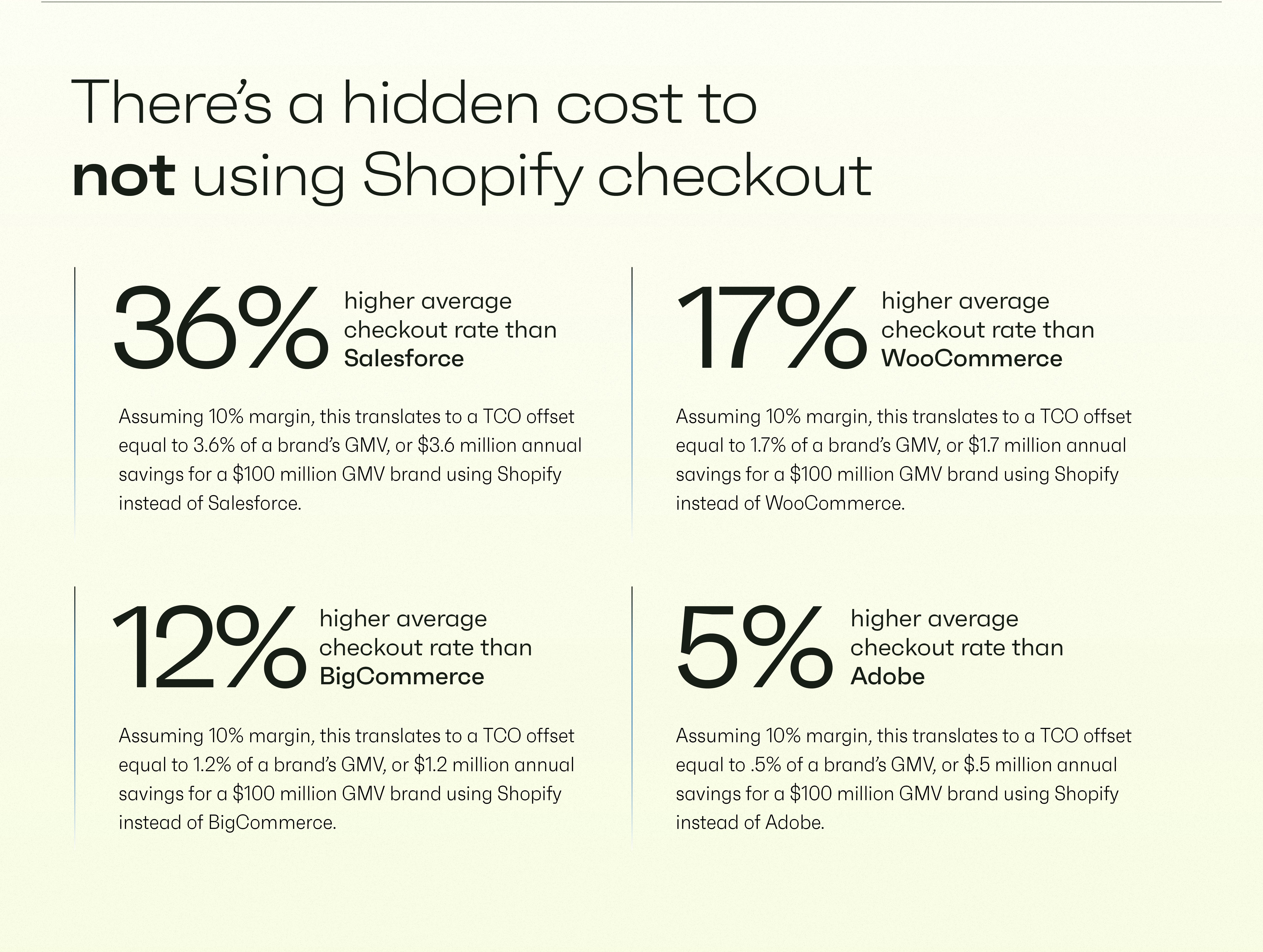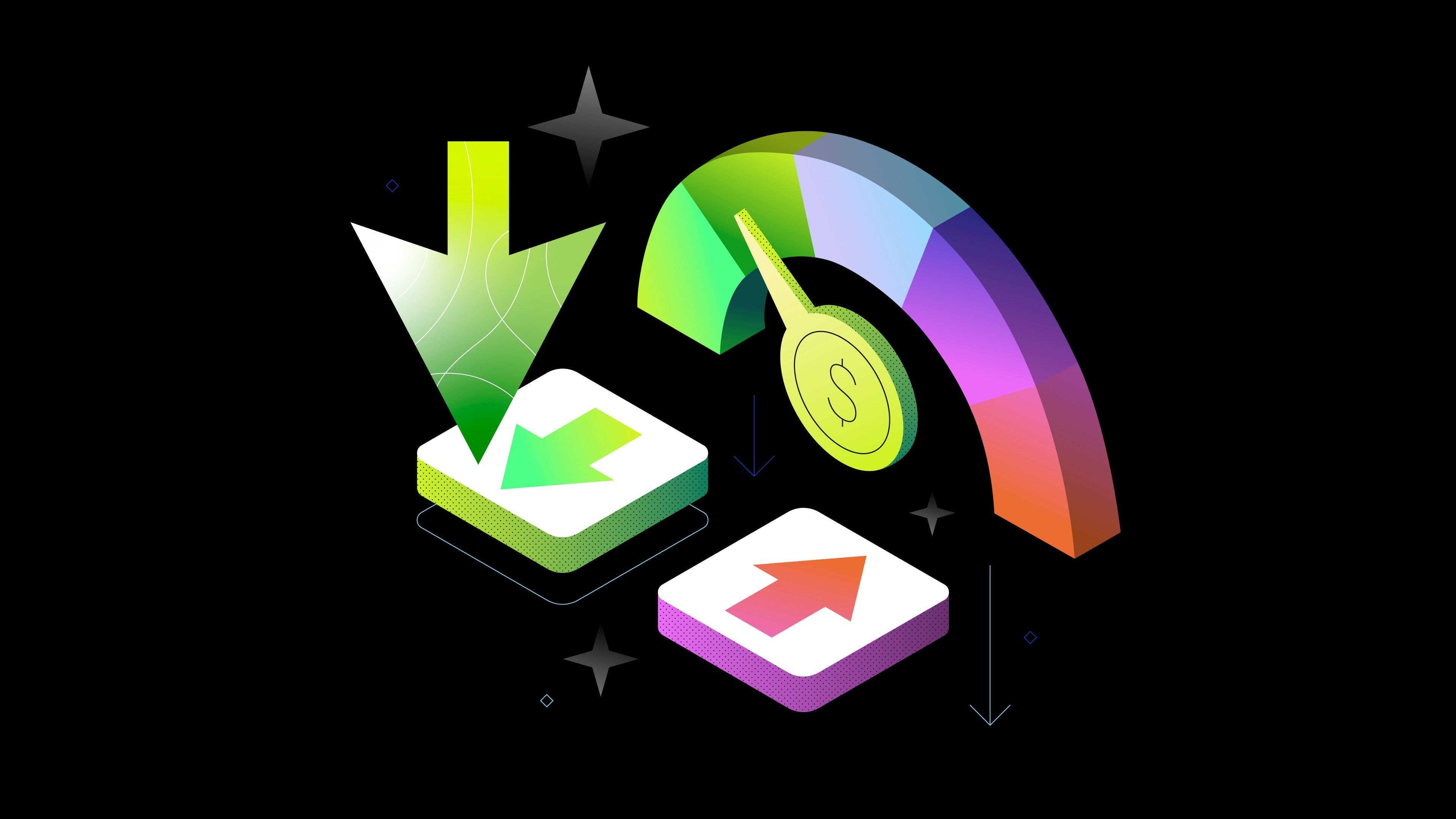The most efficient businesses understand that platform costs are not the only considerations when it comes to choosing a commerce platform.
In fact, there are a whole host of costs to consider, including implementation, operational, and support costs, each of which are many layered. What’s more, it’s important to consider the conversion opportunities one platform offers over another—and to view a lower conversion rate as a lost revenue opportunity.
What goes into total cost of ownership calculations?
In order to know how to lower TCO, you have to know what goes into it. So before we dive in, let's look at the many interwoven factors that go into this calculation. This includes both direct and indirect costs, and the cost of labor associated with implementing, managing, maintaining, and upgrading a platform. Then there are the forward-looking factors, such as how much more efficient and capable any given platform can make employees, and how much a platform can increase conversion rates. There are one-time costs versus recurring. And all factors must be calculated across time—a three- to five-year horizon is typical for TCO.
Platform costs
This is what you’re charged to use the platform, whether that’s monthly, annually, or an ongoing percentage of transactions. There may also be fees for payment processing, maintenance and technical support, and account management.
Platform costs are the sticker price. But there's more to it than just that.
Operational and support costs
The more custom the architecture, the higher the operational costs. For instance, architecture that requires on-premise hosting will drive up IT team overhead costs, as you’ll need in-house technical staff and/or third-party vendors to manage proprietary infrastructure.
Operational costs also include all of the back end of order fulfillment and management, such as the technology behind merchandising, managing users, and running imports from the product information manager (PIM), as well as managing new products, promotions, store manager, and store operations. There are also costs associated with managing web hosting, security, data backups, and upgrades.
"With WordPress and WooCommerce, I was completely out of sync with my agency. Every time I needed to change a comma or anything, I had to create specifications, request a quote, wait for the developer to be available.... It was not at all sustainable.
—Vincent Arrouet, CEO and Cofounder, Sunology
Implementation costs
Implementation costs are the costs associated with rolling out a platform, whether to address the needs of a brand new startup launching from scratch or those of a behemoth that’s existed for years on a legacy platform. In the latter case, migration and integration costs are a central factor. The more complex the back-end system integrations, such as with ERPs and financial systems, the more time- and resource-intensive this can be on legacy platforms such as Salesforce Commerce Cloud.
On the opposite end of the spectrum, platforms like WooCommerce, which offer fewer out-of-the-box capabilities, require plugins and third-party applications to offer true enterprise functionality. Even a platform like Salesforce, which offers more out-of-the-box capabilities, can be pricey for large-scale implementations, given the need to integrate many back-end systems.
As with operational costs, the amount of technical help needed, whether from internal or external sources, can drive up the cost of implementation, as do the availability of the developers who offer this service and the premium they charge for it.
How do you lower the total cost of ownership?
Now that we’ve established what factors go into total cost of ownership, how do you actually lower TCO?
The answer is, you look for a platform that takes on these complexities, and therefore costs, for you.
The main question to ask is: what functionality does the platform offer natively? And if something is native, how straightforward is it to manage? And if they are provided in platform, how convoluted is the platform to manage? Even the most talented technical teams have limited bandwidths. The more time they spend just trying to get features to work, the less they have to spend working on innovative and forward thinking initiatives.
Shopify’s streamlined yet robust software architecture actively promotes innovation because it comes with the right amount of out-of-the-box functionality for both B2B and B2C businesses, with new features released at tremendous speed and scale.
The Shopify app ecosystem also makes the Shopify platform incredibly extensible. Adding new features on other platforms that don’t offer certain features natively may cost hundreds of thousands if not millions of dollars to develop. On Shopify, it’s highly likely that the feature you need already exists in our app ecosystem for far less—and is available in a few clicks.
Shopify’s thousands of engineers keep a constant pulse on feature demands, releasing hundreds of new features with each Edition every six months. Shopify spent $1.7 billion on R&D in 2023 alone. This is in contrast to competitors that often release new features in only the single digits every year.
This many features, plus the ability to integrate more at a low price and time cost, significantly reduces TCO. It also creates the more intangible benefits of being able to innovate as quickly as customer behavior evolve. Rather than employing devs to work through an ever-growing backlog of maintenance tickets, on a platform like Shopify, they can focus on innovations that grow revenue. With flexible integrations, APIs, and automations, they’ll spend less time and money managing multiple platforms.
“There were a lot of things we couldn’t do [on other platforms]. Every single one of those has been unpacked and solved. Now, we're having exciting conversations. They're about what we are doing next, not what we are trying to fix.”
This same functionality and ease of use applies to how business users interact with the platform. Non-developers like members of your marketing team should also be able to self-serve rather than being overly reliant on internal or external developers.
"On Shopify, the marketing team can just do what they need to do. If they want to change a banner or run a new promotion, they can do that in a matter of a few clicks and get data back quickly, versus relying on multiple people and external vendors to drive the business."
Compare that to relying on an overstretched technical team on a legacy platform, with a list of priorities a hundred features deep.
In ecommerce, it costs to have a low-converting checkout
It’s easy to think about conversion solely as an “in the green” calculation. But when it comes to reducing TCO, the opportunity cost of not going with the platform that offers the highest converting checkout should be factored in as an actual one.
Shopify previously commissioned a monthslong research project from a Big Three global management consulting company into Shopify’s conversion rates versus that of our competitors. That study found that Shopify converts up to 36% better than the competition, and by an average of 15%.
The findings also indicate a conversion lift by as much as 50% when using Shop Pay, our accelerated checkout offering, as opposed to guest checkout, outpacing other accelerated checkouts by at least 10%. The mere presence of Shop Pay, according to the study, can increase lower funnel conversion by 5%.
Shopify's checkout converts 18% higher on average than the 4 competitors evaluated in the recent TCO research we commissioned. When expressed as a percent of TCO, assuming a margin of 10% on goods sold, that translates to a roughly 1.8% TCO offset.
Here’s how that stacks up:

How time to market impacts TCO
It’s important not to focus on one-time implementation costs. Taking the time to get an implementation right will save you in the long run.
However, the long-run benefits must be balanced with time to market. To ensure the process is speedy, research the time-to-market estimates given by platforms sales teams versus what actual customers report. Are projects frequently delivered on time or even significantly before the buzzer? Or do customers talk about time to market on the platform you’re interested in like they do a construction project: “If they say six months, expect at least a year”?
Timelines that overrun often involve downtime that negatively impacts the user experience, representing a conversion loss.
There’s a simple way to lower your TCO
Look for the platform that offers the most out of the box capabilities, extensibility, and flexibility. The one with the fastest time to market, and thousands of engineers dedicated to constantly releasing new features.
FAQ on improving TCO
What does TCO mean?
TCO refers to total cost of ownership. It is a calculation of all the costs that go into owning a product, both direct and indirect. Generally, TCO is calculated within a three- to five-year horizon. For a commerce platform, it should include platform, implementation, and operation and support costs, while also building in a comparison of conversion rates.
How do you get the lowest TCO?
Look for a platform that offers robust out-of-the-box features, while building in flexibility and extensibility for easy customization. It should also provide an elegant, streamlined infrastructure to reduce time to market, allow for maximum agility that keeps pace with changing customer demands, and maximize conversion opportunities.
What is an example of a TCO?
The total cost of ownership for a commerce platform is one example of TCO. This should include factors that go beyond platform fees to include operational and support costs, implementation costs, and the opportunity costs of going with one platform over another when their conversion rates are compared side-by-side.
What is TCO in optimization?
An optimized TCO seeks to drive down costs across all cost categories, while increasing conversion rates to generate higher GMV.





